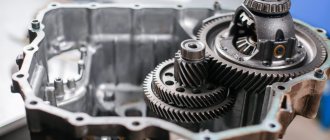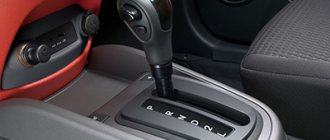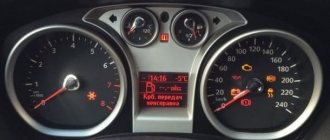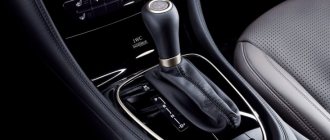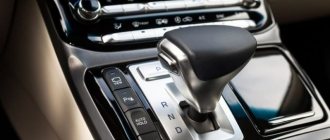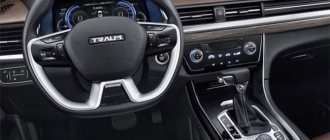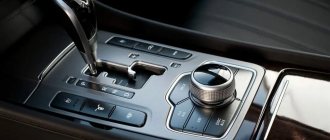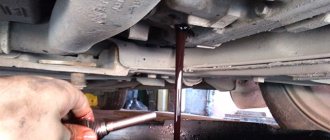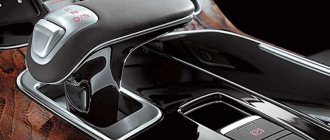The active development of the automotive industry continues today thanks to the introduction of the latest technologies in this industry. In modern cars, the manufacturer invests a large margin in terms of dynamic and power characteristics, improves the level of equipment, safety, etc.
At the same time, a lot can depend on the quality of implementation of a particular technical solution, including the life and health of the driver, passengers, and other road users.
Note that, given the great popularity of automatic transmissions, the “S” (Sport) mode is designed to fully experience the “drive” of driving a car. Also, this mode can help the driver in a difficult situation. In this article we will look at what “S” gear is on an automatic transmission, why this mode is needed and how to use it.
What is an automatic transmission
The transmission is the link between the wheels and the engine. This is the most common device that changes torque. Its design includes many different mechanisms and parts:
- torque converter;
- Manual Transmission;
- control system.
On a note! The design of passenger cars with front-wheel drive may also include a differential and final drive.
The torque converter reduces vibration. The operating conditions of the chassis and engine are becoming better. In order for the car to move in reverse, there is a manual gearbox in the automatic transmission. With its help, a stepwise change in torque occurs. Such a box consists of planetary gearboxes, the number of which depends on the brand of car. The control system consists of input sensors, an electronic control unit, a distribution module and a selector lever.
Peak loads are increasing
In general, the fuel is enriched with oxygen, and the engine demonstrates more performance. Of course, it does not become stronger, but the software dampers are removed, which smoothed out peak shock loads and made the power and torque curve more even. When a sports program is activated, these loads increase sharply, which provides a more emotional drive.
However, for this reason, the sport mode cannot always be combined with gearboxes whose peak torque is no more than 150 Nm. For example, the modern variator installed on the Lada X Ray has an operating torque of just 150 Nm, which makes it impossible to use sport mode buttons with this transmission and the 1.6-liter 113-horsepower engine. Therefore, the “Sport” programmer is installed on Lada only with a manual gearbox and a 1.8-liter naturally aspirated engine.
When the “Sport” program is activated, the increase in dynamics is felt up to a speed of approximately 70 km/h. The engine no longer has enough strength to provide active drive. The rate of acceleration drops, and the responsiveness of the engine decreases. At speeds above 100 km/h, the effectiveness of the sport mode is no longer noticeable.
Basic operating modes
There are several modes that a self-driving vehicle has. These include:
- Position before start. The lever is set to position “P” (parking). This is a mode when the car is stationary with the engine not running. Used when stopping for a long time. The car starts from this position.
- Start position. The lever is in the neutral position “N” (neutral). This means that the engine is started but is idling. Recommended for use during short stops, for example, at traffic lights.
- First phase of movement. The lever is set to o (drive). This is the main mode, when activated, the car moves forward and the gears change independently. It is used for constant driving, except for ice, snow, long ascents and descents at large inclines.
- Accelerating a car. Installed in low gear “D3” - this is when only the first 3 gears are engaged. Recommended when driving on dirt roads, when driving up and down.
- Even stroke. Modes “D2” and “D1” when speeds are less than 50 and 25 km/h, respectively. Recommended when driving on a difficult route in the forest, on a slippery or snowy road or on a mountain serpentine road. "D1" is also used when driving in a traffic jam.
There is also “D4”, when the average driving speed reaches 100 km/h. It is recommended to use it on a flat road. This mode is also called smooth transmission.
A short note on how to start driving with an automatic transmission
- Put the lever in position P or parking
- Turn the key in the ignition and start the car engine
- Squeeze the brake and, holding it pressed, set the lever to position D drive.
- Gently release the brake and add gas and start moving.
- Remember that when changing any position of the speed lever you must depress the brake pedal
- Also, on the automatic transmission, it is highly not recommended to tow anyone or pull a trailer - you are overloading this automatic transmission, which will lead to its rapid wear or even failure immediately at the time of towing
- With an automatic transmission, towing a stalled car is carried out in the N neutral lever mode, and the towing itself can be done at a distance of no more than 50 km at a speed of no higher than 30 km.
If you have a question about what is better, automatic or manual, then read here, and our article entitled - automatic transmission, the meaning of letters and numbers has come to an end, here we looked at the most common designations on automatic transmissions of cars, if you have anything to add or ask fellow motorists, reflect this in the comments under this article.
We also recommend watching a video of what the letters on the automatic transmission box mean.
Letter designations on the lever
There are several types of automatic transmissions, but the abbreviations for them are almost the same. This was done in order to make driving as easy as possible for the driver, and when transferring from a vehicle with a classic automatic transmission to a car with a CVT or robot, he did not experience any difficulty or discomfort.
On a note! Despite the fact that the automatic transmission on different car brands will be different, the designation of numbers and letters will be slightly different (they indicate the main and additional modes).
It is important to know and understand the speed symbols on the automatic transmission. Thanks to this, the driver will ensure comfortable driving and will know how to properly operate his vehicle depending on weather conditions.
The design of the machine is similar in appearance to a manual box, where letters and numbers are indicated next to the lever:
- 2 and 2L;
- 3;
- D or A;
- E (Economic);
- kickdown;
- L or B;
- M (Manual);
- N (Neutral);
- OD (Over Drive);
- P (Parking);
- S (Sport);
- W (Winter);
- R (Reverse).
2 and 2L means that movement is possible in 1st and 2nd gear at a speed of 40 km/h and below. Recommended for use when driving on steep, winding roads in the mountains. 3 is used when driving at the first 3 speeds on a hilly road and during constant stops, when the speed does not exceed 80 km/h.
Drive or Automate are necessary for comfortable movement of the vehicle forward. The automatic shifts from 1st to the last speed available in the gearbox. The mode is used when driving around the city, where the weather conditions are good. Drive remains operational when the car is forced to stop for a short time, for example, at traffic lights.
E (Economic). The mode allows the car to move smoothly while saving fuel. Economic prevents the car from accelerating or moving quickly. This is due to the fact that shifting occurs at low rpm.
Kickdown is activated when high acceleration is needed, for example when overtaking. The moment of transition occurs when the pedal is pressed to the maximum. When it is released, the gearbox returns to normal operation.
L or B (Low or Bottom). Indicates slow motion. It is recommended to use when the road goes steeply up or down, as well as when there is ice, snow or when driving with a loaded trailer. The mode is activated only at speeds up to 30 km/h. On some models it is indicated by a lowercase letter “l”.
On a note! There are car brands that use the letter “B” to indicate differential locking. Then it is prohibited to activate this mode when driving at a speed of more than 30 km/h. In most cases, this designation is found on crossovers and SUVs with an automatic transmission.
M (Manual) - the driver can drive the car manually. This mode is not provided on all automatic transmissions. Typically displayed with "+"/"-" marks to indicate upshift and downshift. There are car brands in which the function can be activated by pressing special switches located under the steering wheel, or by using a rocker button located on the lever.
N (Neutral) - neutral gear. As a rule, it is used when towing a car or when starting the engine. It is important to understand that the car can roll if you do not brake or pull the handbrake in a timely manner. When standing for a long time (from 10 minutes) with the engine running, select mode N.
OD (Over Drive). This mode is an analogue of D3 for driving on the highway at variable speeds from 50 to 70 km/h. At 60 km/h you need to switch to 4th gear, when reducing speed - to 3rd. Such shifts can quickly lead to wear on the automatic transmission. That's why Over Drive is so necessary when driving around the city or while overtaking. At 80 km/h and above, the mode must be turned off.
P (Parking). Indispensable when the vehicle is idle for a long time. In addition, it can be used when the car is parked on a slope. First, pull the handbrake and then turn on the Parking mode. Thanks to this, the service life of the locking mechanism will not decrease.
S (Sport). Sports mode, in which gear changes are carried out at high speeds. By pressing S, maximum engine power is used. Designed for active and fast driving, when overtaking or during sharp acceleration from a standstill. Depending on the brand, auto mode is designated as:
- POWER;
- S;
- SPORT;
- AUTO;
- A/T MODE.
W (Winter) - winter mode, which can also be indicated as a snowflake or HOLD. In winter, it allows the car to move off smoothly, without slipping in the snow or sliding on ice. Depending on the brand of car, the use of the mode differs, so it is recommended that you first read the instructions.
R (Reverse) - moving in reverse. Switching on is only possible when the machine is completely stopped. Otherwise, there is a possibility of serious damage to the automatic transmission.
On a note! When parking a vehicle on a slope, before pressing the car in reverse, you should press the brake pedal.
The photo below shows how and where the values are written on the gearbox.
Common mistakes when using automatic transmission
- The most common mistake that leads to automatic transmission failure is turning on the “D” mode - “drive” (moving forward) without a complete stop when moving in reverse
. And, the same thing, only in reverse - turning on the “R” mode (reverse) without completely stopping when moving forward.
The second common mistake (rather, misconception) is related to the “N” (neutral) mode. The fact is that this mode is an emergency mode to unlock the wheels for short-term towing or moving the car in case of any malfunction. And only for this!
But many inexperienced drivers use the neutral “N” mode in traffic jams during short stops
, which leads to water hammer and premature wear of the automatic transmission. In traffic jams with frequent stops, you need to use mode “D” together with the brake pedal. If you need to stop, the brake pedal is pressed; if you need to move forward slowly, the brake pedal is simply released and the car slowly rolls forward. And you can drive like this all day.
The third error is the transition to neutral mode “N” from mode “D” on the move, while driving on the highway
. This is dangerous (especially at high speed), as the engine may stall, as a result of which the power steering and brake power will be turned off, and the car will become almost uncontrollable.
Another mistake is towing a car with an automatic transmission over a distance of more than 40 km and at a speed of more than 50 km/h
. In an automatic transmission, unlike a manual transmission, the oil supply system operates under pressure, but when towing it does not work. Accordingly, the parts of the “machine” rotate “dry”, without lubrication, as a result of which they wear out very quickly.
. And although such attempts often lead to the desired result (the engine starts), it still has a destructive effect on the automatic transmission mechanism, and with such frequent use, the “automatic” may not even use up half of its intended resource.
Conclusion
It is quite possible that for some, the automatic transmission will seem like a complex and finicky mechanism, despite the simplicity and ease of use. But this is only at first glance. In fact, “automatic machines” have proven themselves to be quite reliable units, but, of course, subject to their correct and competent operation. It is especially convenient to use automatic transmission in big cities, where you often have to get stuck in traffic jams.
Video on how to use the machine:
Rules for using automatic transmission
There are basic rules that should be followed when driving an automatic car. They will avoid damage and increase service life.
- First you need to start the engine. Then press the brake pedal to the maximum and activate mode D. Next, turn off the handbrake and smoothly release the brake. The car should begin to move smoothly, just like with a manual transmission. You can adjust the speed using the accelerator pedal.
- When you press on the gas, the vehicle accelerates. When changing gears, slight shocks will be felt.
- To reduce the speed, you should gradually release the gas pedal and the box will reduce gears with a decrease in speed.
- To rapidly reduce speed, press the pedal brake. Then the selector is moved only after the vehicle has finally stopped.
It is necessary to start moving after you feel a push, which indicates that the gear is fully engaged. If the vehicle is stalled, it is not recommended to press the gas: this will have a negative effect on the main gear and on the gearbox itself. It is better to turn on the downshift mode and work the brake like a clutch. Due to this, the wheels will rotate more slowly.
Driving a car with automatic transmission is easy and comfortable. Before operation, it is important to refer to the vehicle’s manual and study all the instructions on the automatic transmission. This will allow you to quickly navigate in various situations and know in which mode it is comfortable and safe to drive in certain cases.
when to use "S" mode on automatic transmission? Is it really needed?
I read on the Internet that it seems to be very good in icy conditions, is this really so? I’ll be riding Demio in Siberia for the first winter, I’d like to know what this mode does, what are its features? Reviews. The tires are already studded (if that matters, of course).
I never turn it on at all. I always go to D. What it’s needed for, I have a vague idea)
For snow Hold - you start in second, there is no fourth. I sometimes turn on S when you are driving around the city at such a speed in traffic and the gearbox jumps first to 3, then to 4 and back, but also on long descents. S is SLOPE - Slope. We have mountains.
Actually, the SLOW is slow, leisurely, the mountains have nothing to do with it, the car is not for mountain rangers. L - LOW - low.
Last edited by Tru-la-la; 10/21/2012 at 07:49.
S-slope, a mode used for driving on mountain roads. Movement occurs in 1, 2, 3 gears. In this range, the engine braking mode is effectively used. Mode L-movement in 1, 2 gears - here engine braking is realized to the maximum. Used on steep slopes descents, ascents, off-road.
Recommendations and explanations of the car manufacturer
where is slush or towing?
Damn, they confused it even more, it’s strange that no one said that the S mode is sport))) until the picture is complete. Grandfather on Demio, thank you, but for the life of me I don’t know how to understand the phrase “engine braking release”.
During a long (long) descent, in addition to the braking system, the inertia of the engine is used - just release the gas pedal (for modes S and L). It is very effective on slippery roads - the car does not skid and braking occurs smoothly.
Last edited by Grandfather on Demio; 10/21/2012 at 12:30 pm.
thank you, it’s clearer)) that is, use it on a long, even icy descent. But just driving around the city, even in icy conditions, doesn’t make sense)))
I sometimes use S around the city when there is heavy traffic. It is very convenient for sharp accelerations up to about 80 km per hour, from traffic light to traffic light))
Why is it so official? I live in the private sector and in the off-season it washes out, slightly, so I turn it on with hold, or without it, or I pulled the car (I had to, I know it’s harmful, but then no way) and so little by little
When I need effective engine braking (in particular, when driving hard before a turn), I use S+HOLD. It's just that S has little effect. It's the same on the descents.
Last edited by Tru-la-la; 10/21/2012 at 10:13 pm.
Author You apparently haven’t driven through the passes. Sneaker on the floor, speed 60-70, constant adventures from 3 to 4. Only S saves.
It’s a pity that the three-speed gearbox doesn’t have HOLD; often in a traffic jam you have to shift to 1, otherwise the box may start switching from 1 to 2 and back at high speed.
Or maybe it’s worth thinking about the reasons for such abnormal operation of the box? A slipper on the floor is a kick-down mode, it should not go to 4th. I don’t observe such twitching in myself when climbing a mountain (albeit not a very long one, but still 800 m in one case and about 200 m of a very steep climb in the second, I constantly go to that part of the city that we call the mountain, who knows - there is room for the car to show bad inclinations), not in traffic jams. Just like the notorious shocks, which are often complained about, I observed only when the idle or ignition timing settings were violated.
I didn’t even say that my gear doesn’t hold during kickdown. There's nothing wrong with that. Another thing is that the three-speed gearbox has an unpleasant feature - at certain speeds and driving at low speeds, the box begins to shift 1-2 back and forth. In this case, it helps to either slow down and drive in 1, or put on the gas and drive in 2. But in traffic jams this is inconvenient, since you still end up with a lot of switching, so it’s easier to stick in 1. This has already been written about here several times. The figure shows that the switching moments 1-2 and 2-1 are quite close, it seems to me that this is exactly the point. And it is still not clear under what conditions the torque converter locks up in the FA3A-H? For FN4 and FA4 this is shown in the graphs
That’s why it’s not clear that it’s not in this box. :) Another author wrote about kick-down.
Last edited by Tru-la-la; 10/24/2012 at 05:38.
We need to look at what is happening with the vacuum in the intake manifold. It is doubtful that on a working engine any significant work will be realized in the zone of the graph where the vertical lines are closely spaced, since when you press the gas pedal the vacuum drops sharply and work becomes in the zone where the lines are inclined and far from each other. Or the cross-section of the vacuum-conducting path may also be reduced (the tube is pinched, the channels in the throttle body or box are clogged, etc.), resulting in throttling and a slower change in pressure. So, purely considerations when looking at the graph, since I have never checked this. :) But I think that the twitching is still a defect outside the scope of normal operation.
Volkswagen Taos automatic: reliability and disadvantages
Recently, representatives of our garage community have been faced with the problem of choosing one or another configuration of the Volkswagen Taos: either a 110-horsepower assembly option paired with a 6-speed automatic or 5-speed manual, or with the presence of 150 horses, motor adaptation with a 7- or 8-speed manual transmission. -speed automatic transmission by robot.
Again, not long ago, to our brother-auto-philistine, two-pedal, 6-mode wet-type robotic transmissions, such as the DQ250 DQ381 megalopolis traffic jams. .
It should be borne in mind that at the forefront of transmission innovations was the Czech Karok, which, as is known, is the predecessor of the Taos we are considering, which copied not only the appearance, but also the transmission filling of the Czech.
However, over time, Taos, due to being equipped with an 8-mode hydraulic automatic transmission AQ450 produced by Aisin, began to be technologically ahead of its Czech brother, which now forced Skoda to carry out the reverse procedure of unification with the transmission filling of the Volkswagen model.
Robotic boxes DSG VF Taos: characteristics and reliability
The attitude of our garage brothers towards DSG transmissions is traditionally different, namely, representatives of the older generation garage community categorically do not accept the presence of only two pedals under the steering wheel, but the younger generation, on the contrary, prefer exclusively automatic gear shifting.
At the same time, young people, although not all of them, are nevertheless pleased with the accelerating dynamics of robots, and the experienced and conservative audience of our community first of all strives, horrified, to calculate the possible costs of both maintenance and repair of automatic transmissions.
Although, according to manufacturers, supposedly new automatic transmissions have gotten rid of the shortcomings of old automatic gearboxes. And now Taos owners are increasingly pleased with both the clarity and perfection of gear shifting and the long-term, problem-free operation.
| Automatic transmission VW Taos | DQ250 | DQ381 | AQ450 |
| Clutch type | wet | wet | torque converter |
| Total clutches | 2 | 2 | 4 clutch packs |
| Volume and location of the engine | 1.6MPI, across | 1.4 TSN across | 1.6MPI/1.4 TSN, transverse |
| Rotation moments | 350Nm | 420Nm | 450Nm |
| Automatic transmission oil | G052182A2 | ATFG055529 | G055540A2 |
| Oil pumps | one | two | one electromagnetic with cooling |
| Number of gears | 6 | 7 | 8 |
| Oil change schedule | After 60 thousand | After 120 thousand | In 200 thousand |
| Transmission lubricant volume, l | 7,2 | 7,0 | 7,65 |
| Orientation of input shafts | coaxial | coaxial | |
| Approximate resource | 200 thousand | 150 thousand | 300 thousand |
| Start-stop option available | — | There is | There is |
Weak points of DG250
Preselective (this is when the choice of the next speed is carried out in advance before it is turned on or those gearboxes that have two clutches) DSG-6 automatic transmissions are vulnerable when driving in stops, which corresponds precisely to driving conditions in traffic jams. Since, when working in forced start/stop modes, solenoids are subject to wear much faster than during constant, albeit under load, operating conditions on long-distance highways. As for the most common breakdowns of the DQ250 , these are:
- failure of the same solenoids;
- friction clutches;
- mechatronics electronic control unit.
How it works: why do you need manual mode in an automatic transmission?
The same applies to situations when the serpentine road leads upward - unlike a wavy road, where you can save money by increasing the gear, on steep hills the gears will have to be lowered. To make it easier to overcome them. Why, if the automatic transmission will downshift on its own? You don’t have to lower it, but if it’s descent-ascent-turn-descent-ascent, it will be much easier to control the situation yourself.
So, you are ready to go to Crimea (if you are not already on your way). Let's say you decide to go to a resort from Kyiv. Of course, by car. What is important when driving long distances? That's right, savings. Of course, for some it is also important to get there quickly, but now let’s talk about those who want to save money.
Interesting read: Loan forgiveness for the founder in 2022
Sport mode on automatic how it works
For example, a variator has no shift stages at all, and changes in the gear ratio are carried out by a mechanism resembling two conical pulleys. The moving belt simultaneously changes the input and output diameters of the shafts, which changes the output speed without loss of power or jerks. The robot is essentially a high-quality manual transmission with effective electronic control. Mechanical enthusiasts can always switch to their favorite mode.
Today, most drivers have no idea how they would drive a car that does not have an automatic transmission. Some beginners are horrified at the thought of having to constantly change gears manually. Many experienced drivers also realized long ago that driving with an automatic transmission is much more convenient. Despite all this, people are tormented by the question - how to properly operate an automatic transmission? This article will discuss exactly this.
How to drive an automatic car - engine braking
If there is a need to brake engines with automatic transmissions, then there are two options. The first is to follow these steps:
- Activate overdrive mode. The automatic transmission automatically switches to the 3rd stage.
- If you are driving at a speed less than 90 km/h, then in manual mode, shift the transmission to the second stage. The car will immediately begin to slow down; naturally, do not press the gas pedal at this time.
- If you are moving at a speed of less than 50 km/h, then switch the transmission to “L” mode.
The second option is applicable when driving on a slope. You need to do the following:
Place the gearshift lever in mode S (up to 90 km/h) or L (up to 50 km/h).
- Do not press the gas pedal during the entire braking process.
- Periodically depress the brake pedal until you come to a complete stop or reach the set speed.
